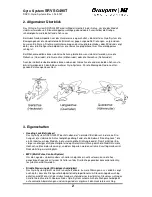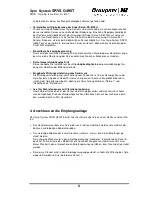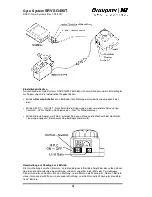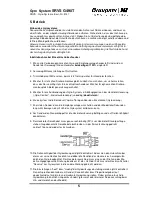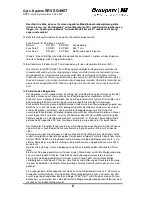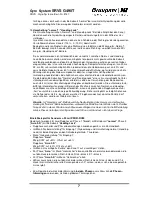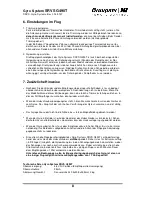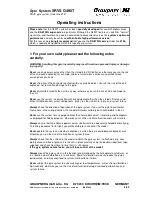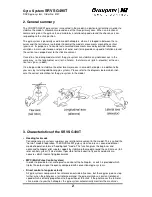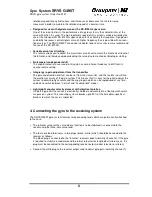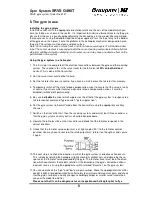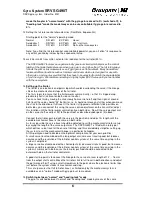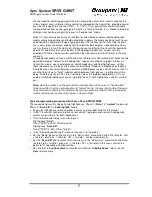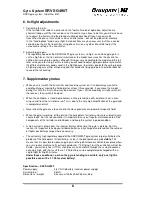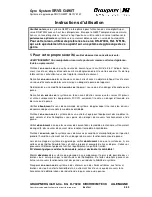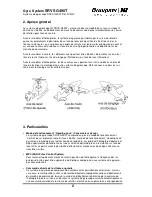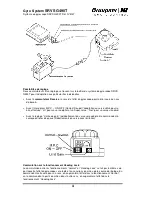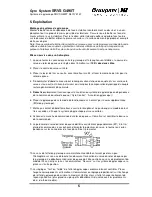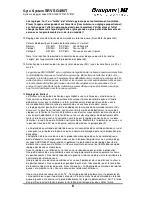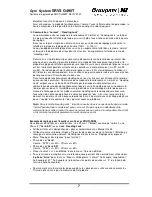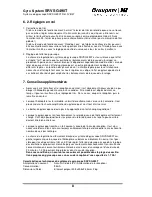
Gyro System
SRVS G490T
SRVS gyro system, Order No. 5137
8
6. In-flight adjustments
1. Correcting the trim
If the tail rotor trim slider is not central in the "normal" mode of operation, adjust the me-
chanical linkage until the trim can be re-set to centre. If you have to do this, you will also have
to re-adjust the limiter using the procedure already described. If you have an mc-24
transmitter the phase trim can be used as an alternative - but not the global trim memory.
In the "heading lock" mode very slight trim corrections may be necessary, but these can be
corrected on the mc-24 transmitter using phase trim; on any other transmitter adjust the
servo centre setting at the transmitter.
2. Adjusting gyro gain
The regulatory speed of the SRVS G490T gyro system is so high - even when gyro gain is
set to a high level - that in normal circumstances the model never reaches the onset of os-
cillation (tail swinging to and fro), although this does vary according to the model and the tail
rotor servo you are using. For this reason you will need to adjust gyro gain primarily to match
the different rotational speeds used in the flight phases: low rotor speeds for hovering require
a higher gyro gain setting; at higher speeds for aerobatic flying gyro gain should be reduced,
to avoid the tail hunting.
7. Supplementary notes
•
When you first switch the transmitter and receiving system on it is absolutely essential to
avoid touching or moving the helicopter for at least three seconds. If you move the model
during this time the trim setting may be incorrect. If you shift the model by mistake switch off
the receiver, then switch it on again.
•
When the helicopter is standing motionless on the ground you will sometimes hear a hum-
ming sound from the tail rotor servo. This is due to the very high amplification of the gyro and
is completely normal.
•
Never allow the gyro case to come into the close proximity of a powerful magnetic field!
•
When the gyro is working, all the parts of the helicopter’s tail rotor system are subject to very
severe loads. For this reason alone it is important to carry out regular maintenance to all the
components of the tail rotor and tail boom, and keep the system in good condition.
•
A high current is drawn from the receiver battery all the time the gyro is working. For this
reason it is important to keep your airborne batteries fully charged, and to reduce the number
of flights per battery charge where necessary.
•
The extremely high regulatory speed of the SRVS G490T gyro system largely eliminates the
problem of the helicopter’s tail oscillating - at least, the phenomenon is not visible. This
means that it is possible to advance gyro gain to the point where oscillation takes place when
you set up your machine to fly extreme aerobatics ("3-D flying"), but the oscillation will not be
visible - you will only hear it. If this should occur, current drain through the system becomes
extremely high, with the result that a 1.2 Ah battery can be completely discharged within a
single flight lasting 20 minutes.
Under these conditions, i.e. when the gyro is tending to oscillate, only one flight is
possible even with a 1.7 Ah receiver battery!
Specification – SRVS G490T
Power supply:
4,8V Ni-Cd battery (receiver power supply)
Current drain:
95mA
Dimensions / weight:
Sensor unit 30,5x30,5x24,5mm, 28g

